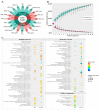Comparative Genomics of Eight Fusarium graminearum Strains with Contrasting Aggressiveness Reveals an Expanded Open Pangenome and Extended Effector Content Signatures
- PMID: 34200775
- PMCID: PMC8230406
- DOI: 10.3390/ijms22126257
Comparative Genomics of Eight Fusarium graminearum Strains with Contrasting Aggressiveness Reveals an Expanded Open Pangenome and Extended Effector Content Signatures
Abstract
Fusarium graminearum, the primary cause of Fusarium head blight (FHB) in small-grain cereals, demonstrates remarkably variable levels of aggressiveness in its host, producing different infection dynamics and contrasted symptom severity. While the secreted proteins, including effectors, are thought to be one of the essential components of aggressiveness, our knowledge of the intra-species genomic diversity of F. graminearum is still limited. In this work, we sequenced eight European F. graminearum strains of contrasting aggressiveness to characterize their respective genome structure, their gene content and to delineate their specificities. By combining the available sequences of 12 other F. graminearum strains, we outlined a reference pangenome that expands the repertoire of the known genes in the reference PH-1 genome by 32%, including nearly 21,000 non-redundant sequences and gathering a common base of 9250 conserved core-genes. More than 1000 genes with high non-synonymous mutation rates may be under diverse selection, especially regarding the trichothecene biosynthesis gene cluster. About 900 secreted protein clusters (SPCs) have been described. Mostly localized in the fast sub-genome of F. graminearum supposed to evolve rapidly to promote adaptation and rapid responses to the host's infection, these SPCs gather a range of putative proteinaceous effectors systematically found in the core secretome, with the chloroplast and the plant nucleus as the main predicted targets in the host cell. This work describes new knowledge on the intra-species diversity in F. graminearum and emphasizes putative determinants of aggressiveness, providing a wealth of new candidate genes potentially involved in the Fusarium head blight disease.
Keywords: Fusarium graminearum; Fusarium head blight; aggressiveness; intra-species genomic diversity; pangenome; proteinaceous effectors; secreted protein clusters.
Conflict of interest statement
The authors declare no conflict of interest.
Figures







Similar articles
-
Fusarium graminearum Infection Strategy in Wheat Involves a Highly Conserved Genetic Program That Controls the Expression of a Core Effectome.Int J Mol Sci. 2022 Feb 8;23(3):1914. doi: 10.3390/ijms23031914. Int J Mol Sci. 2022. PMID: 35163834 Free PMC article.
-
Genome-Wide Analysis of Small Secreted Cysteine-Rich Proteins Identifies Candidate Effector Proteins Potentially Involved in Fusarium graminearum-Wheat Interactions.Phytopathology. 2016 Feb;106(2):166-76. doi: 10.1094/PHYTO-09-15-0215-R. Epub 2016 Jan 13. Phytopathology. 2016. PMID: 26524547
-
Landscape of genomic diversity and host adaptation in Fusarium graminearum.BMC Genomics. 2017 Feb 23;18(1):203. doi: 10.1186/s12864-017-3524-x. BMC Genomics. 2017. PMID: 28231761 Free PMC article.
-
Transcriptomics of cereal-Fusarium graminearum interactions: what we have learned so far.Mol Plant Pathol. 2018 Mar;19(3):764-778. doi: 10.1111/mpp.12561. Epub 2017 Jun 7. Mol Plant Pathol. 2018. PMID: 28411402 Free PMC article. Review.
-
Resistance in wheat to Fusarium infection and trichothecene formation.Toxicol Lett. 2004 Oct 10;153(1):37-46. doi: 10.1016/j.toxlet.2004.04.044. Toxicol Lett. 2004. PMID: 15342079 Review.
Cited by
-
The landscape and predicted roles of structural variants in Fusarium graminearum genomes.G3 (Bethesda). 2024 Jun 5;14(6):jkae065. doi: 10.1093/g3journal/jkae065. G3 (Bethesda). 2024. PMID: 38546739 Free PMC article.
-
Distribution, Function, and Evolution of a Gene Essential for Trichothecene Toxin Biosynthesis in Trichoderma.Front Microbiol. 2021 Dec 2;12:791641. doi: 10.3389/fmicb.2021.791641. eCollection 2021. Front Microbiol. 2021. PMID: 34925301 Free PMC article.
-
Suboptimal pre-anthesis water status mitigates wheat susceptibility to fusarium head blight and triggers specific metabolic responses.Sci Rep. 2025 Apr 6;15(1):11773. doi: 10.1038/s41598-025-96159-4. Sci Rep. 2025. PMID: 40189612 Free PMC article.
-
CoreDetector: a flexible and efficient program for core-genome alignment of evolutionary diverse genomes.Bioinformatics. 2023 Nov 1;39(11):btad628. doi: 10.1093/bioinformatics/btad628. Bioinformatics. 2023. PMID: 37878789 Free PMC article.
-
Identification of a Highly Virulent Verticillium nonalfalfae Strain Vn011 and Expression Analysis of Its Orphan Genes During Potato Inoculation.Plants (Basel). 2025 Apr 23;14(9):1281. doi: 10.3390/plants14091281. Plants (Basel). 2025. PMID: 40364310 Free PMC article.
References
-
- Desjardins A.E. Fusarium Mycotoxins: Chemistry, Genetics, and Biology. APS Press; St. Paul, MN, USA: 2006.
MeSH terms
Supplementary concepts
Grants and funding
LinkOut - more resources
Full Text Sources

